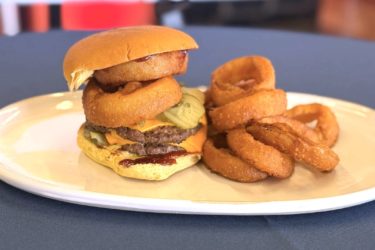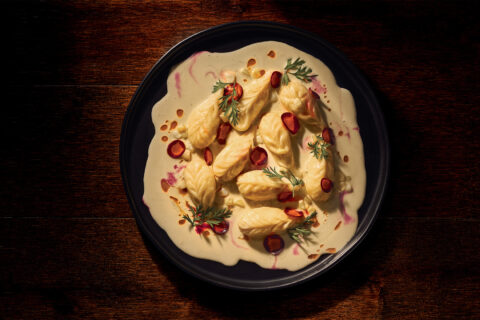The Local newsletter is your free, daily guide to life in Colorado. For locals, by locals.
All signs point to summer 2020 being a big season for the grill. Following months of quarantine, we’re all desperate to dine somewhere other than at our kitchen table, maybe even with people we don’t live with (fewer than 10 and socially distanced, obviously). An open-air, backyard barbecue couldn’t sound more delightful—unless your steak is sub-par, or you’re so stressed about drying out the pork chops that you can’t enjoy your guests’ company. To help you steer clear of such catastrophes, we got in touch with the chef behind some of Denver’s best animal-centric eateries, including Old Major, Masterpiece Delicatessen (inside Old Major), and Royal Rooster (at Broadway Market): Justin Brunson.
Also the owner of River Bear American Meats, a USDA production facility in Denver, plus a butcher and deli counter inside Leevers Locavore (the deli counter, called Culture Meat & Cheese, also has locations in Denver Central Market and Denver International Airport), Brunson unsurprisingly knows his way around a grill. So whether you’ve been searing steaks for years or aren’t entirely sure what “sear” means, Brunson’s tips, tricks, and recipes will make you feel like the Fire Master all summer long.

Start Talking
With your butcher, that is. “Ask your butcher about the meat. Where it comes from, what it’s fed, what breed it is,” says Brunson. He’s a big proponent of buying from local butchers who work with smaller operations that raise their animals humanely. “I want to buy my meat from a butcher that has the same morals that I do,” Brunson says.
Brunson, who grew up on a farm in Iowa, prefers pasture-raised, grain-finished animals, which means the bovines ate corn for the final 120 days leading up to slaughter. He’s not a fan of animals that were on antibiotics, either. “Those animals aren’t really in the best living conditions,” Brunson says. “Too many animals packed into too small of a space makes disease spread rapidly. That’s why they feed them antibiotics.”
Bottom line? It might be worth spending an extra buck or two per pound for the pasture-raised stuff. Get a bigger cut, too, ideally more than an inch and a quarter thick—thin cuts dry out quickly. “The better meat you start with,” Brunson says, “the better success you’ll have with your grill.”
Gear Up
In the great charcoal-versus-gas grill debate, Brunson comes down on the side of charcoal. “The temperature gets hotter. And the natural flavors that come off the melting fat when it hits the charcoal has better flavor than propane,” he says. “Plus, any chance I get to start a fire, I’m in.”
Starting that fire, according to Brunson, is best done the good old-fashioned way—with a chimney starter, which is a metal column with space for charcoal on the top and newspaper on the bottom (you can find one at most hardware stores). Don’t use charcoal doused with lighter fluid, which can give your food a chemical taste.
Of course, Brunson says, it’s fine to use whatever grill you’re comfortable with, gas grills included. Just make sure to scrub it down with a grill brush before using, and clear any debris at the bottom of the grill to promote airflow. You’ll also want a long pair of metal tongs to help shift charcoal and food around, as well as a meat thermometer to check for doneness.
Control The Heat—And Yourself
Brunson doesn’t have a thermometer monitoring the temperature of his charcoal grill. Instead, he goes by sight. The grill is usually hot enough when the charcoal turns grey, for example, and flare ups indicate it’s too hot. Avoid them by using the dampers on your grill, those grates you open and close to control air flow. If you want the grill hotter, open the dampers; close them to cool things off.
Brunson also piles the charcoal in one spot to create hotter and cooler cooking areas. “If things start to get a little too hot, I can always move it to the cooler part,” he says. On a gas grill, you can achieve hot and cool zones by turning the outside burners to high and keeping the middle burner on low.
Finally, when it’s time to take your meat off the grill, tap into the same patience you showed during the stay-at-home order and rest the meat, to avoid having the juices run out too quickly. A small, fist-size cut of meat, such as a burger, only needs five minutes rest or so, Brunson says. A two- to-three-inch cut should rest for 10 minutes, and a four- to-five-inch cut can rest for as long as half an hour.
With all this in mind, Brunson walked us through four grill recipes, each progressively more challenging. So pour yourself some bourbon, if you’re so inclined—Brunson likes sipping Colorado Springs-based Distillery 291’s offering while wielding his tongs—and get cooking.*
*If you’re really trying to channel Brunson, queue up some Phish.
For the Novice: New York Strip Steak
“The New York Strip is thicker and doesn’t have a lot of excess fat, so it keeps the flare-ups down. You just need salt and pepper. I have never been a huge fan of using all the different marinades and those types of things. I want to taste the meat.”
Start with a cut of meat thicker than two inches. Sprinkle with freshly ground black pepper and coarse salt—Brunson likes fleur de sel—and rest the steak at room temperature for 20 to 30 minutes. Meanwhile, heat the grill. Toss the strip steak on the hottest part of the grill and cook, turning once, until the outside has a dark-brown crust (that’s what searing means, by the way). Move the steak to the cooler part of the grill and cook until your thermometer reads 123 degrees, for medium rare. Let the steak rest for 10 minutes, then slice against the grain.
For the Intermediate Griller: Stuffed Branzino
“Grilling a whole fish can be challenging, but the branzino is pretty forgiving because the bones release juices as it cooks, keeping it moist. Ask your fishmonger to eviscerate the branzino—take all the guts out—and make sure that they scale it for you as well.”
Stuff lemon wedges and the fresh herbs of your choice into the fish cavity created by the evisceration. Smear a bit of olive oil on the outside and sprinkle with fresh ground black pepper and salt. Tie the fish with twine to keep the lemon from falling out. Toss onto a hot grill. After eight minutes, turn the fish. Grill for another eight minutes, or until the flesh is falling off the bone. Don’t worry if the outside chars; that crisp skin contrasts nicely with the tender inside. Rest the fish for 10 minutes before serving.
For the Expert: Spatchcocked Chicken
“Ask your butcher to spatchcock, or remove the backbone, of a whole chicken, but leave the skin and other bones. All those things make the meat juicier.”
Brine the chicken in the refrigerator for 24 hours in a half gallon of water mixed with a quarter cup of salt and a quarter cup of sugar. Remove the chicken from the brine, pat it dry, and slather it with Tabasco sauce or vinegar. Sprinkle on a dry rub of your choice—Brunson likes using lemon pepper and Lawry’s seasoning salt. Heat the grill, but keep dampers closed to prevent it from getting too hot (if you’re using a gas grill, aim for roughly 300 degrees); cooking at a lower temperature helps the skin get crispy without burning. Arrange the chicken bone-side down on the grill and cook, turning once, until the chicken thighs reach 180 degrees and the breast reaches 165 degrees. If you want, brush the chicken with a sauce, such as barbecue or hoisin, five minutes before taking it off the grill. Rest for 15 minutes before serving.
Read More: We Blind-Sampled 10 Colorado-Made Hot Sauces So You Don’t Have To
For the Grill Master With Time To Burn: Brisket
“You can smoke a brisket on a Weber, but it’s a little easier if your cooker has more air-flow, like a Traeger or Yoder smoker. You cook it real low-and-slow, though there’s kind of a newer school where you cook it at 275 degrees for eight hours, instead of cooking it at 225 degrees for 18 hours. I like to hang out with my people, so I use the hot, fast method.”
Trim away any gristle and dangling pieces from the outside of the brisket. Trim excess fat, as well—a layer much thicker than a quarter inch will burn. Set the trimmed fat aside. You want the brisket to be roughly the shape of a bullet, with no thin strips of meat hanging off the sides. Brunson estimates he trims away about 30 percent of the original brisket. Add the trimmed fat to a pot of water on the stovetop and melt it down on a low temperature until most of the water evaporates (this is called rendering). While the fat renders, slather the trimmed brisket with mustard, Lawry’s seasoning salt, and black pepper. Put it on a 275-degree grill or smoker and cook until the outside gets dark. Wrap in butcher paper, which allows the smoke to penetrate. Mix together a ratio of 1:1 apple cider vinegar and water, and spray the brisket. Baste with the rendered fat. Every 45 minutes, open the grill and mist with the water-vinegar spray. Remove the brisket from the heat when it reaches 203 degrees. Allow to rest in a cooler for about three hours. Slice and serve with a sauce of your choice—though the brisket will be so tender, you won’t need any.
Read More: Justin Brunson Wants to Redefine the Deli Case With River Bear American Meats








